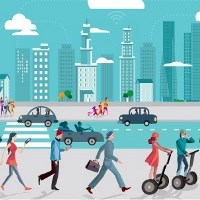The impact of Covid-19 on Global Mobility
SMART & CONNECTED MOBILITY
The impact of COVID-19 on mobility has been brutal but the way back is clear for those who will adapt. In this interview with The Innovation Group, ROGER LANCTOT, Director Automotive Connected Mobility, Global Automotive Practice, STRATEGY ANALYTICS, anticipates some of the insights he will present during the SMART & CONNECTED MOBILITY SUMMIT LIVE 2020, next July 8th, 2020.
TIG. At the beginning of 2020, more and more countries across the globe had to shut down their borders and limit travel to contain the Covid-19 outbreak. Since then, the pandemic has affected almost every dimension of economic activity and individuals globally, with relevant consequences for supply chains, the automotive and transportation industry: what are the main measures to shake off the effects of the pandemic and return to profitability?
Roger Lanctot. The automotive and transportation industries have some reliance on public authorities as they work toward recovery from the current crisis. For auto makers, the foremost challenge is restoring their supply chains and ramping up vehicle production to meet was is expected to be and is shaping up to be robust demand. This also means, though, that most car makers are left to their own devices to respond to and negotiate with labor representatives to ensure sufficient safety measures are in place including distancing, sanitization, testing, and tracing and mask wearing. Most European and U.S. factories have already come back online – with some intermittent subsequent shutdowns resulting from individual positive tests for COVID-19. The outlook is positive, though it is clear that supply and demand for cars will take several years to recover to full pre-COVID-19 levels.
In the public transit space multiple public transit authorities have put measures in place from frequent cleaning, mask wearing, and distancing to adding cars. The expectation is that there will be some reduction in demand due to public concerns regarding the coronavirus and the inability to ensure safety in all circumstances. Some decline in ridership will be difficult to avoid – especially as passengers return to driving their personal vehicles and/or using ride hailing services. There will also be a decline due to an increase in unemployment along with an increase in remote working.
The mobility economy has taken an even more severe hit from the pandemic than public transportation. As economies re-open, ad hoc transportation options such as ride hailing, car sharing, taxis, and micromobility will recover as well. Accommodation measures will be required in these sectors including distancing, mask wearing, and sanitization. Ride hailing operators and taxis, in particular, have already been taking measures to add in-vehicle partitions to protect drivers and passengers. These measures will be essential for the sector to fully bounce back. There may also be some consolidation among operators.

TIG. Covid-19 had a disruptive impact on the way we live and move around, on cities and society as a whole, but has led also to an acceleration in the use of digital technologies: are we expected to see a new wave of innovation also in public transport and mobility services? Broader adoption of open platforms and analytics to drive technology-enabled mobility services?
Roger Lanctot. We have seen the widespread use of anonymized data during the pandemic to better understand how citizens are moving, and where. Unfortunately, the pandemic has also highlighted how digital technology can be used for good and for ill in the process of tracking and tracing of infected citizens. In spite of the existence of privacy rules and regulations, some countries such as South Korea and Israel were quite aggressive regarding the leveraging of this type of data. The pandemic has highlighted the reality that we have not fully resolved this privacy issues.
Digital platform players including Facebook, Amazon, Apple, and Google have benefited mightily during the pandemic. They have made multiple acquisitions and taken advantage of the need for new means of shopping and sharing information. The chorus of resistance to this rampant aggregation and consolidation of economic power and the potential for abuse is growing and evolving into legislation. For now, the big are getting bigger and are continuing to disrupt traditional industries – including both automotive and transportation. Intel/Mobileye’s acquisition of Moovit is one of the more benign manifestations of this trend.
TIG. Improving transportation and mobility with attention to the safety of people is today a priority for the city decision-makers, with actions as improving walkability for pedestrians, incentives for micro-mobility, new infrastructure for electric vehicles, shared mobility, tighter regulation for private cars, etc. As an example, in response to the coronavirus crisis, Milan has introduced one of Europe’s most ambitious mobility schemes, reallocating street space from cars to cycling and walking. According to many statistics, the largest share of smart city projects implemented today is in the field of smart mobility: what can we expect for urban mobility soon?
Roger Lanctot. The post-pandemic shift away from public transportation to private alternatives is likely to accelerate these trends. Cities like Milan, Shanghai, and New York have seen the air clear along with their streets during the crisis. The pandemic created an opportunity to accelerate public works projects without the intrusion of traffic, but it has also stimulated imagination and spurred cities to action. The shift toward a pedestrian-centric cityscape and the reduction of individual vehicle traffic has been given new impetus. This enthusiasm will only be further fuelled once the twin impact of the shift from public transportation and the increase in private travel manifest on city streets in the coming months. Mobility-as-a-Service-style options putting an emphasis on shared transportation and facilitating and restoring the use of public transportation will emerge strongly before the end of 2020.
REGISTER HERE to participate to the SMART & CONNECTED MOBILITY SUMMIT LIVE 2020 !!!!
The Agenda of the Summit.


